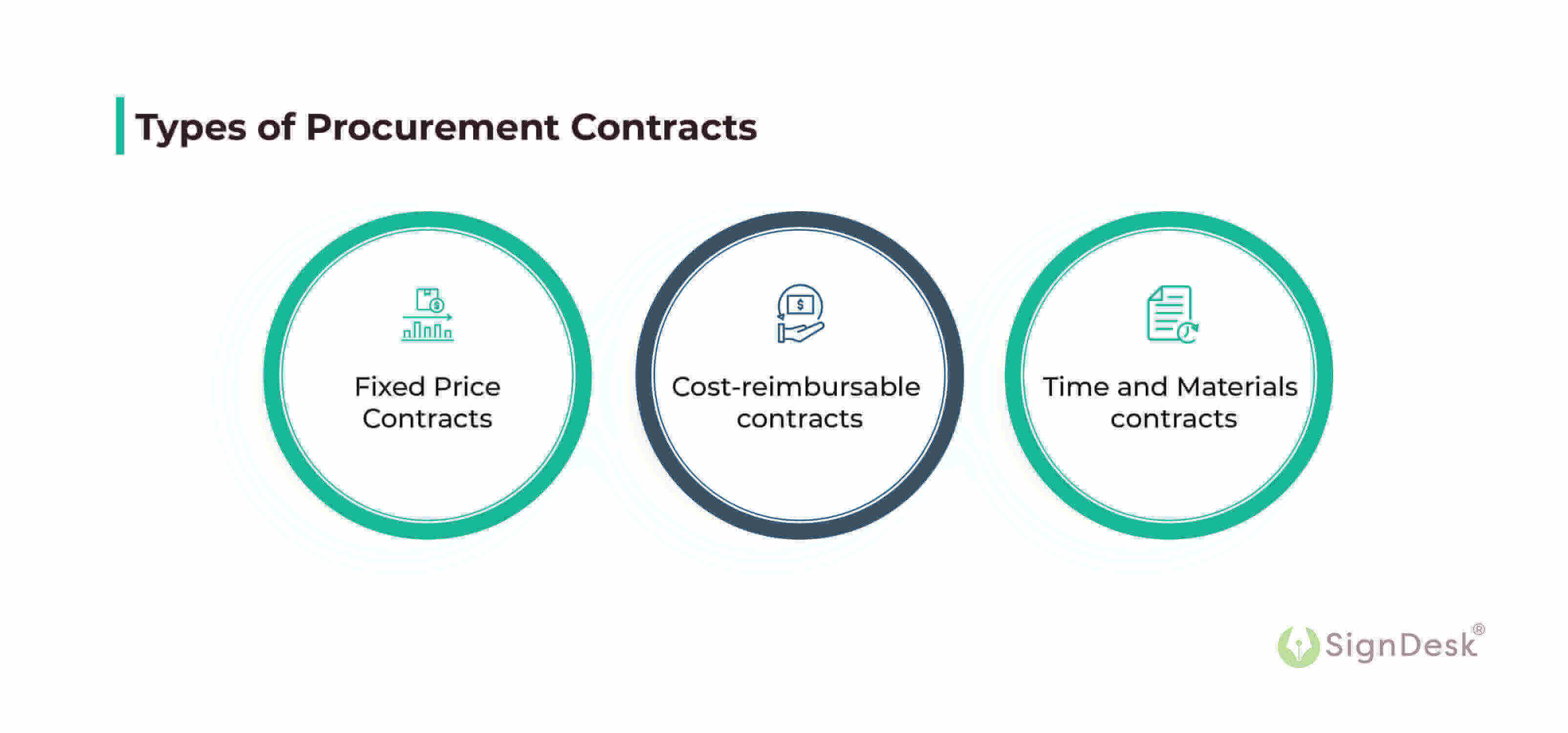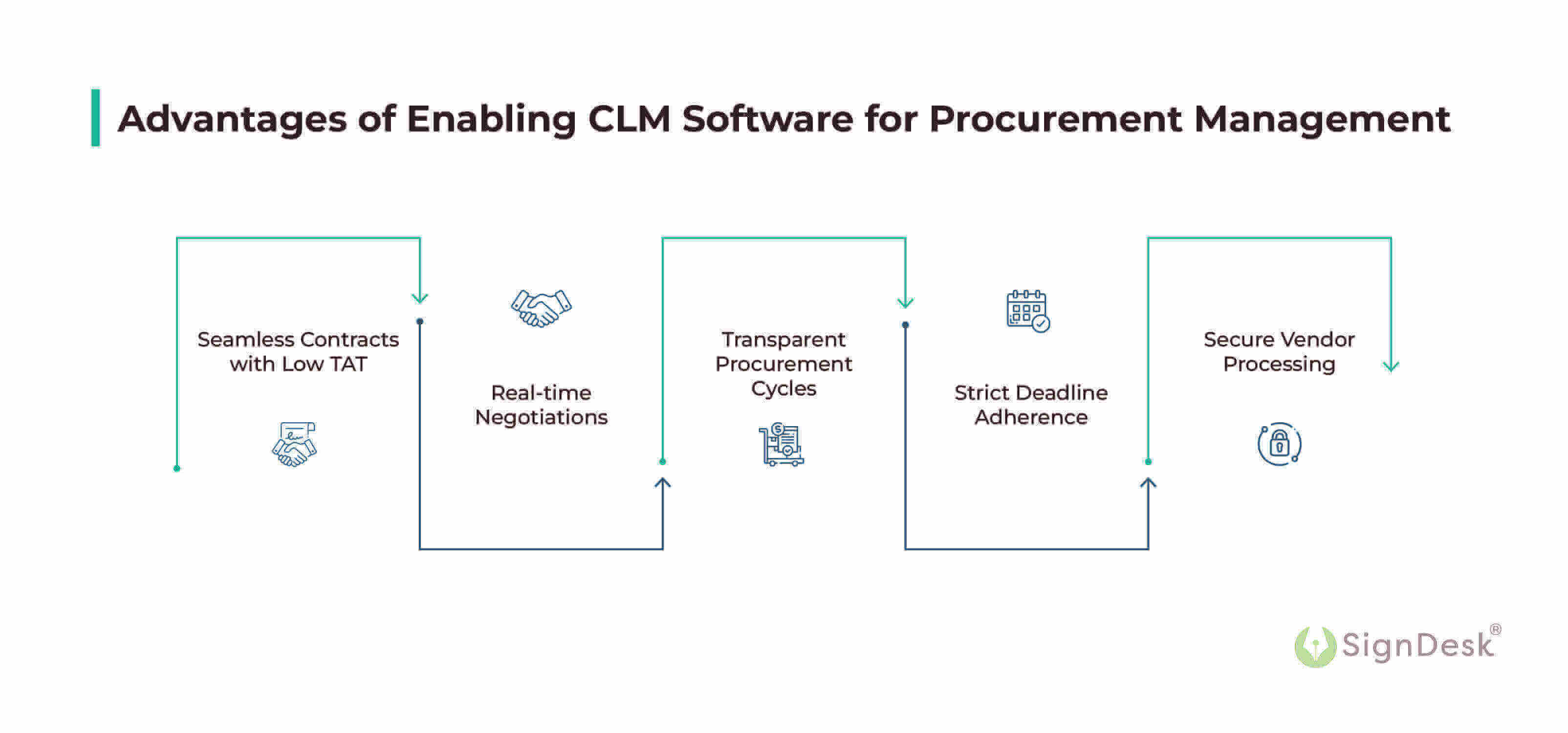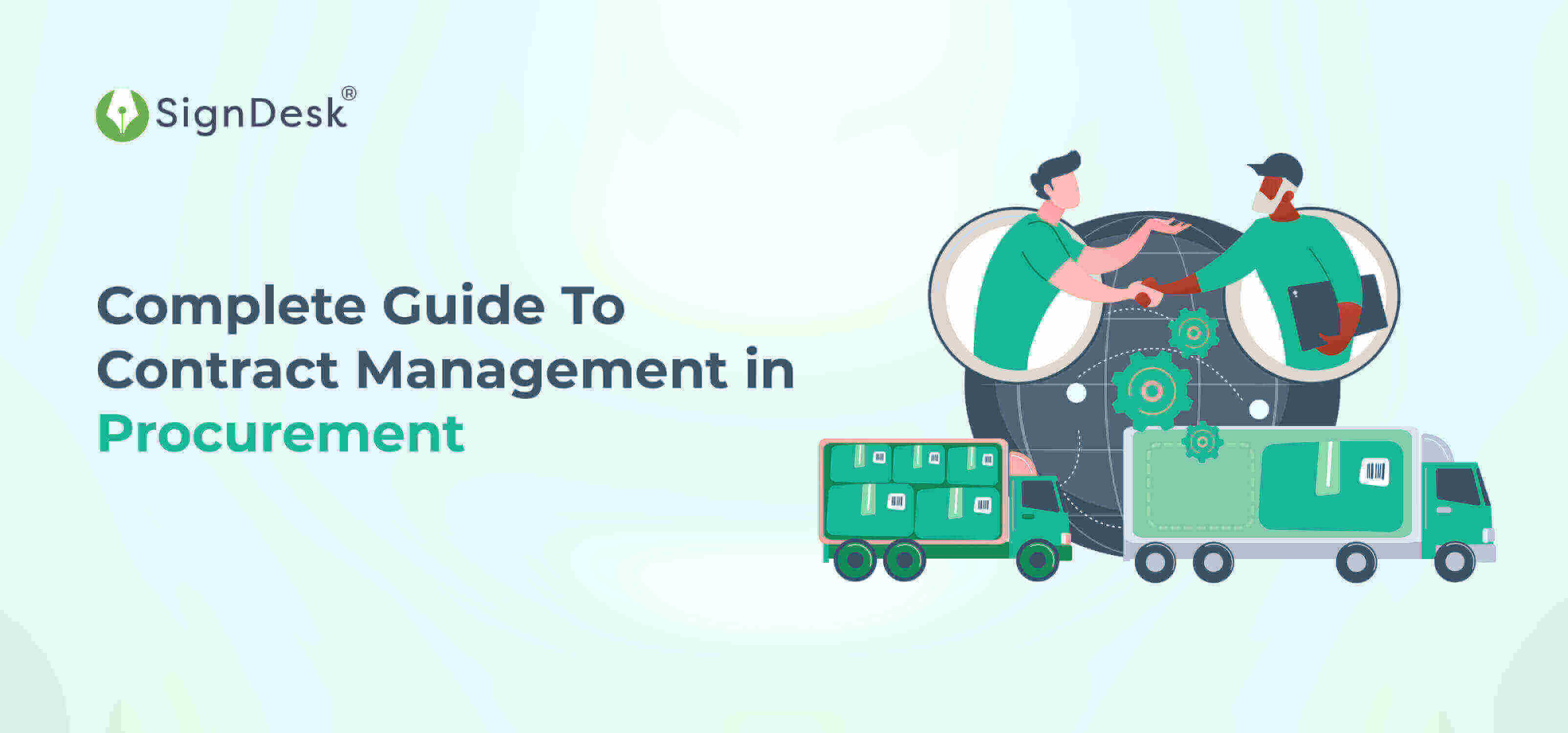Contract Management in Procurement – Overview
Procurement contracts, also known as purchase contracts and agreements between buyers and sellers that create a legally binding relationship that protects both parties during the procurement process.
So what is contract management in procurement? In simple terms, it is the process of maintaining contracts connected to procurement and purchases established as part of the legal paperwork for creating work connections with customers, vendors, or even partners. The procurement contract management process, facilitated by legal contract management software, entails negotiating contract terms and conditions, obtaining signatures, and tracking contract performance.
Several business teams still rely on manual procedures & spreadsheets to manage contracting in procurement during the pre-and post-award stages of buy-side contracts. In these cases, the overall administration of contracts becomes inefficient, expensive, and risky.
Digital transformation in procurement contract management can help businesses accomplish essential objectives such as cost reduction, increased agility, and increased organisational efficiency.
Contract Lifecycle Management (CLM) technology is a useful tool for procurement managers to automate procurement contracts from drafting through to signatures and renewal.
The Contract Management Process for Procurement
Organisations monitoring procurement of contracts manage expenditures and supports operations by acquiring high-quality goods and services on schedule. Improving the performance of this strategic function results in cost savings, risk reduction, and improved buying strategies.
On the other hand, procurement and contracting teams frequently rely on manual procedures, spreadsheets, and siloed systems, resulting in lengthy lead times.
Types of Procurement Contracts
The procurement contracts generally used are divided into broadly three different sub-parts:

- Fixed Price Contracts: With a fixed-price contract, the buyer assumes the little risk. This is excellent for the project’s risk register, but not so much for the project’s budget. Because the seller assumes all of the risks, the price is usually increased to account for potential hazards.Utilising the contract helps in any procurement cycle. Firms involved in purchase as well as procurement can reduce the prices, execute contracts faster with new parties, reduces compliance risks and manage relationships both internally and externally. Contract procurement includes all of the procedures required for a company to acquire products and services from a vendor.
- Cost-reimbursable contracts: A cost-reimbursable contract requires one to pay the vendor the actual cost of the work. This might be materials, equipment, or anything else, and it will usually include both direct and indirect expenses. Indirect expenses will be a set percentage – they will not bring their power bills and demand that to pay a percentage.The contract will include a provision that permits them to claim a profit above the cost price, either in the form of a set fee or an incentive payment.
- Time and Materials contracts: Time and materials contracts compensate the vendor for items purchased as well as a per day or per hour cost for time invested. The software developers in this scenario will bill on a time and materials basis. There will most likely be few materials in this situation, and they will charge their daily fee for time spent creating and testing the new product.This type of contract is ideal for undertakings in which one doesn’t know exactly what he/she wants before beginning. This may be a very cost-efficient approach to add more resources and abilities to the team keeping a tight eye on expenses and managing the budget and the work so that you don’t overspend.
The contract management in procurement process consists of the following steps:
- Managing contracts as part of the legal paperwork of establishing business partnerships with consumers, vendors, or even partners.
- Contract terms and conditions are negotiated.
- Assurance of conformity with the terms and conditions
- Both parties must document and agree on any modifications.
Procurement organisations manage spending and support operations by acquiring high-quality goods and services on schedule. Improving the performance of this strategic function results in cost savings, risk reduction, and improved buying strategies.
What are the Challenges in Contract Management for Procurement?
While being carried forward as a manual one, the procurement contract management process comes with certain challenges. Procurement is a complex component of a global company with substantial commercial and regulatory risk. Contract problems in procurement include the following:
- High Operational Cost: Manually carrying out a contract takes substantially longer to complete all of the tests. The back-and-forth contact via emails for discussions and approvals wastes time and results in data inconsistencies. In a word, this reinforces the concept that the whole cost of operations is to complete a contract.
- Regulatory Enforcement: Manual contract development in procurement is error-prone and takes substantially longer. Furthermore, if the contract structure and terms and conditions are out of date, it can lead to difficulties like non-compliance, which can further delay its execution. This results in missed project deadlines, which can be costly to the organisation.
- Missed Obligations: Contract and document data storage cause several issues that firms must deal with on a daily basis. Maintaining files and folders for physical documents causes concerns such as a lack of contract visibility, which causes delays anytime the need to review/amend an agreement occurs. Physical contracts frequently jeopardise the confidentiality of the data contained inside them. Contract version control and milestone monitoring are also becoming more feasible.
- Lack of Transparency: One of the primary issues that businesses encounter is a lack of consistency among the many teams and procedures involved in a contract. Contract visibility limits make the overall contract management in the procurement process inefficient from several viewpoints.
Another key issue is of lack of transparency. This causes issues with vendors, clients, and so on. The absence of contract openness and consistency impedes continuing commercial relationships and makes them unnecessarily complex to manage. - Long Turnaround Times: Another significant issue with procurement contracts is the lengthy turnaround time. Contract drafting from scratch or gathering essential facts to build a document can be time-consuming.
The lack of an efficient contract administration system might result in delayed approvals, increasing the TAT. It also makes tracking the time a contract takes at each level difficult, resulting in an inefficient manner for firms to handle their contracts.
Along with these obstacles, firms frequently disregard contract post-execution administration. This is essential for monitoring contract performance and allowing firms to extract critical insights to improve their projects.
Contract Lifecycle Management Automates Procurement
Organizations can be more strategic in their sourcing and contract management by centralizing and automating procurement activities, such as purchasing and supplier communication.
To understand the role of a CLM tool in solving the challenges that persist in the procurement contract process, first one needs to understand the process involved in the contract lifecycle management. It involves the following steps:
- Initiation: This phase initiates the contract procedure
- Drafting: Following receipt of the request, the contract is prepared using a precedent or standard form template
- Negotiation: At this stage, multiple parties digitally negotiate in order to agree on a set of terms and conditions
- Approval: Prescrobed team members proceed with approval in accordance with the hierarchy
- Signing: The final stage that binds the parties to the agreement is signing the contract
- Performance: At this point, parties must comply with all of the contract’s terms and conditions, or face penalties under the contract
- Renewal: The parties involved may review or renegotiate the original contract preserved in the repository. They can also extend contracts that have lapsed.
In the general notion of procurement, the objectives of a contract lifecycle are:
- Identifying and assessing vendors during the pre-purchase stage
- Contract conditions and whether they are being negotiated properly
- Making sure that goods and services are sold at a mutually agreed-upon price
- Ensuring that all quality control criteria are met by products and services
- Assuring that items and services are delivered on time, at the correct location, and in the appropriate amount
- Cost-effectiveness of vendor management is being monitored
- Taking charge of the contract renewal process
At the end of the day, the procurement team must have a sound contract management software and strategy to secure the mutual benefit of all key parties.
Advantages of Enabling CLM Software for Procurement Management
Smart contract lifecycle management software in procurement may significantly minimise process inefficiencies and allow firms to function more efficiently.
Contract Lifecycle Management or CLM solutions have always been cutting-edge solutions addressing all of the issues that businesses have when using a standard document management CLM system.
Some of the big benefits that CLM delivers that can easily solve contract management difficulties can be understood below:

- Seamless Contracts with Low TAT: CLM provides automated contract writing and assembly, allowing firms to develop error-free agreements swiftly. Contract and procurement management compliance becomes simple with smart CLM, which ensures that the contract provisions remain compatible with regulatory standards. Smart CLM features such as clause locking, contract templates, and contract writing wizard enable firms to benefit from a quick and error-free contract creation process.
- Real-time Negotiations: Using a CLM system, parties may discuss terms and remarks or propose in real-time, as opposed to the manual procedure, which requires them to negotiate back and forth, resulting in an excessive number of emails. To streamline the process and safeguard documents, CLM provides suggestion and comment histories, with robust audit trails and strong user controls.
- Transparent Procurement Cycles: CLM solutions store all modifications made to documents, ensuring complete transparency. It informs parties about who made the modifications and when they were made, as well as the responsibilities assigned to the parties and other important information. As a result, everyone participating in the contract is aware of their duties and activities with the contract. Additionally, real-time contract activity tracking and milestone management provide high visibility for crucial procurement workflows. This ensures that teams collaborate seamlessly and nothing falls through the cracks.
- Strict Deadline Adherence: There are no missed deadlines since CLM keeps track of expiry dates, renewals, and other critical data. It also alerts the parties involved when a contract reaches its expiration date and becomes available for renewal. Custom real-time notifications are sent out at every required touch-point to key stakeholders.
- Secure Vendor Processing: Vendor documents are processed & stored in a central repository, for easy search & retrieval. eSign, eStamp & KYC integrations help round out the vendor onboarding process by enabling instant signatures, real-time eStamping, and quick vendor KYC. All vendor profiles are managed on the smart dashboard, and legacy vendor contracts are secured by tagging clause meta-data.
Streamline Procurement Contract Management With SignDesk CLM
SignDesk’s end-to-end contract management tools – CONTR.ACT – allows you to create contracts and negotiate provisions in real time. CONTR.ACT also offers simple eSignature and eStamping connections for executing contracts quickly and securely.
Manage bulk contracts and provide a streamlined workflow procedure, all while cutting TAT by 90%. Automation has resulted in considerable cost savings for our clients.
Explore our ebooks for expert insights on our innovative solutions.
Contact one of our sales professionals to learn more about how our contract lifecycle management and contract review works.
Get a free trial now!
